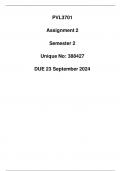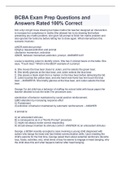Exam (elaborations)
PVL3701 Assignment 2 Semester 2 (388427) Due 23 September 2024
- Course
- Institution
- Book
Question 1 Not yet answered Marked out of 2 QUIZ A composite thing usually consists of three various constituent parts. Which one of the following is not part of a compositething? Select one: a. An accessory thing b. An auxiliary thing c. A fungible thing d. A principal thing Clear my choice ...
[Show more]





